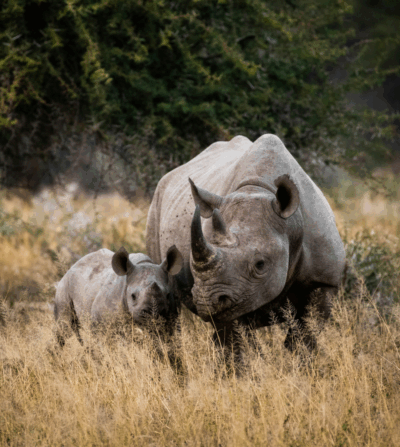
Have you ever wondered what a day in the life of a rhino looks like? In honor of World Rhino Day, here’s how one animal’s daily routine has a BIG impact on the savanna:
The rhino starts her day foraging for grass, leaves, twigs, and fruit. With an average adult weighing 2,000-4,000 pounds, she’ll consume up to 120 pounds of food per day. Mealtime doubles as landscaping. While loping through the brush to graze, she clears vegetation and disperses seeds, helping to maintain the grassland that countless species depend on.
By midday, the heat intensifies, but the rhino knows how to cool off. Using her horn, she digs for water and creates a mud pit. Once she’s covered in mud — a natural sunscreen and insect repellent — it’s time for a nap.
Later, as the air cools, the rhino wanders to find a sturdy tree. The depression from her mud bath forms a shallow pond which small animals can drink from. Rubbing against the tree, she exfoliates her skin and knocks off the nutrient-rich mud which stimulates plant growth wherever it lands.
Through these daily rituals, rhinos do far more than survive — they shape the grasslands themselves. They are ecological engineers whose habits sustain and safeguard biodiversity.
Yet, despite their importance, rhinos face devastating threats. Once abundant throughout Asia and Africa, rhinos have suffered a staggering 95% decline in population over the past century. The primary driver is demand for rhino horn, fueled by its use in traditional Chinese medicine (TCM), and in carvings and jewelry.
Although rhino horn has been banned for 25 years in China, consumption persists on the black market there, and in Vietnam, where some believe it is a cancer cure, general health tonic, and hangover cure. In reality, rhino horn has no proven healing benefits beyond mild fever reduction in very large doses; it’s composed of keratin — the same substance found in human hair and nails.
But hope is growing, thanks to changing attitudes. By reducing demand in rhino horn and supporting a shift within the traditional medicine community toward sustainable alternatives, WildAid and our partners are helping secure a future where rhinos and people thrive together.
Signs of momentum are emerging. In 2023 a survey was conducted of 120 traditional medicine practitioners in Hue Province, Vietnam. Encouragingly, 85% expressed willingness to adopt substitutes for wildlife ingredients. It’s a positive indication of change given a 2022 study by TRAFFIC that found 59% of practitioners had recommended illegal wildlife products — including those derived from rhinos — within the previous two years.
This growing progress is reinforced by larger milestones. On May 18, 2025, TCM professionals from across the world gathered in Vietnam for the Third Conference on Wildlife Protection in Traditional Medicine, where WildAid served as an advisory partner. At the event, Vietnam became the first country to establish a national chapter of the Global Coalition for Wildlife Protection in Traditional Chinese Medicine. Many attendees expressed interest in future collaborations including joint research and the development of wildlife-free training curricula for future practitioners — signaling momentum toward a future where plant-based substitutes replace rhino horn and other animal-derived ingredients.
Each step forward underscores the larger mission: ensuring rhinos are valued for the critical role they play in healthy ecosystems, not for the false claims tied to their horns.
Join WildAid in standing up for rhinos. Together, we can ensure these gentle giants thrive for generations to come.
Stay in touch and get the latest WildAid updates.
SIGN UP